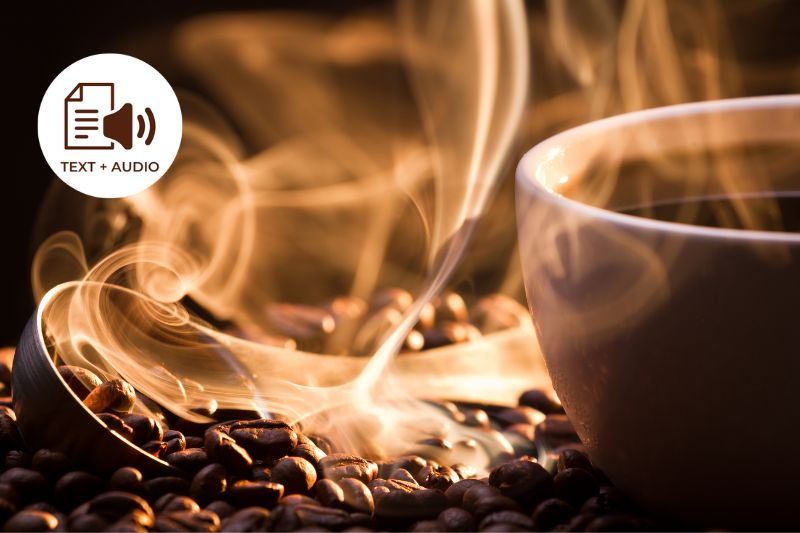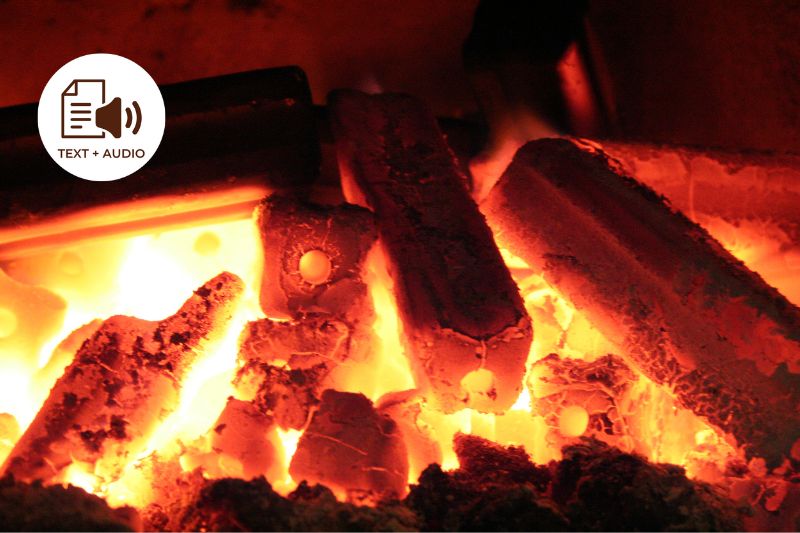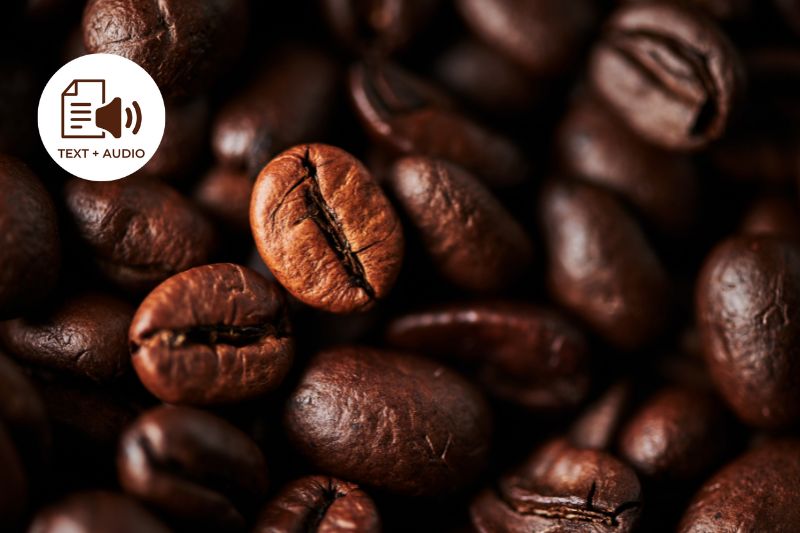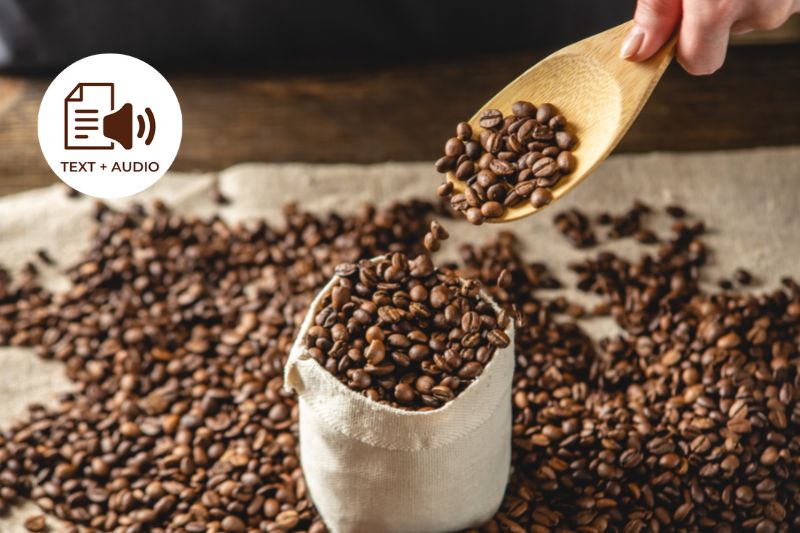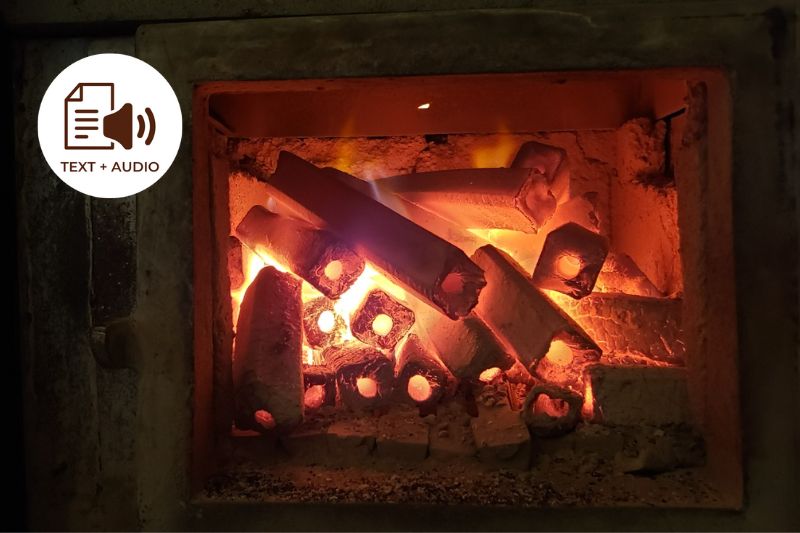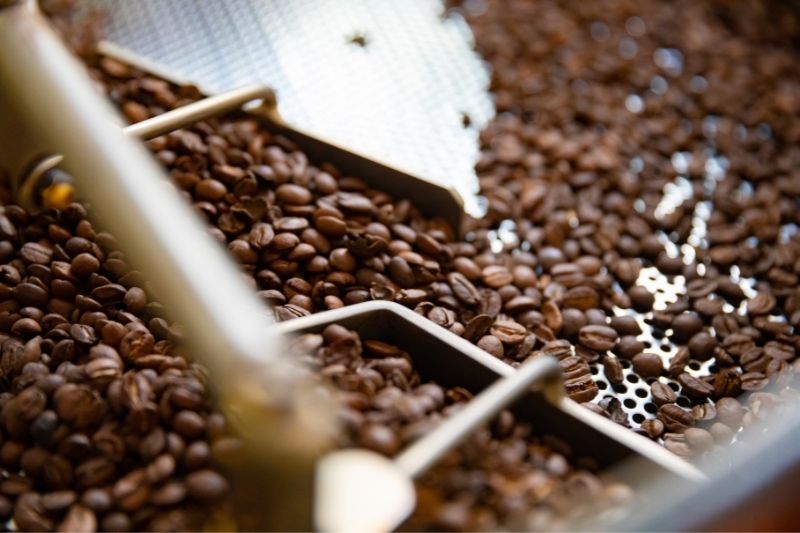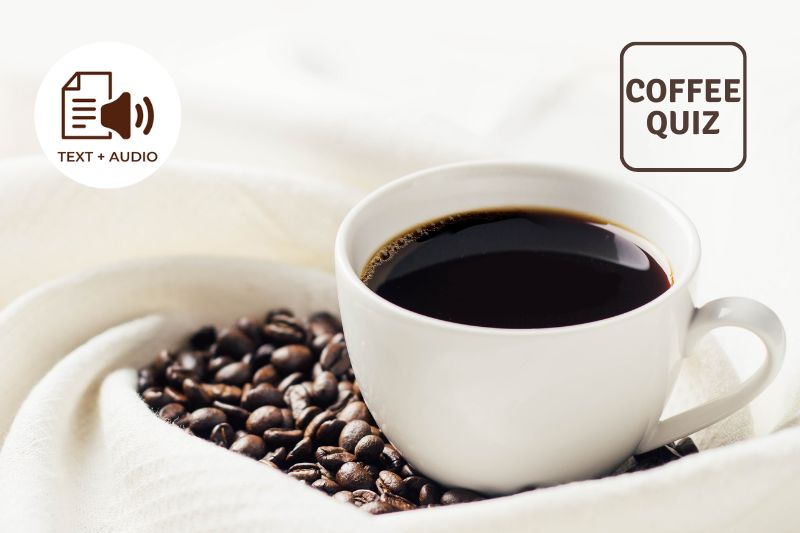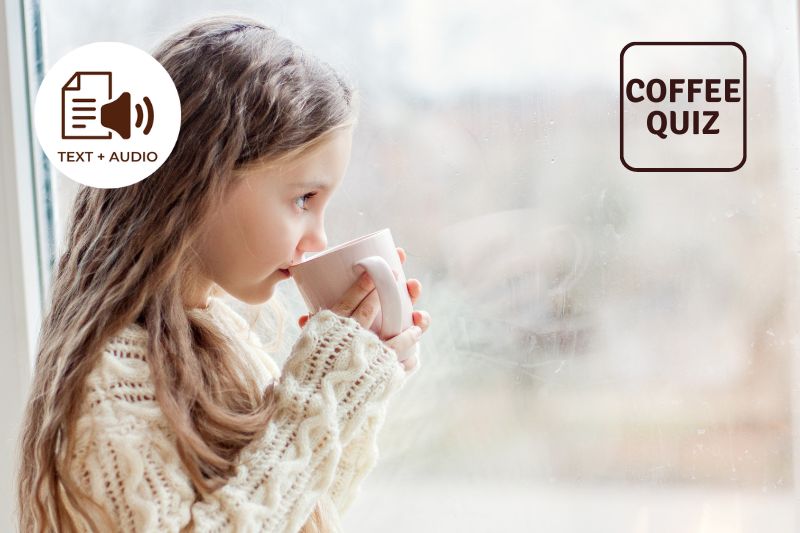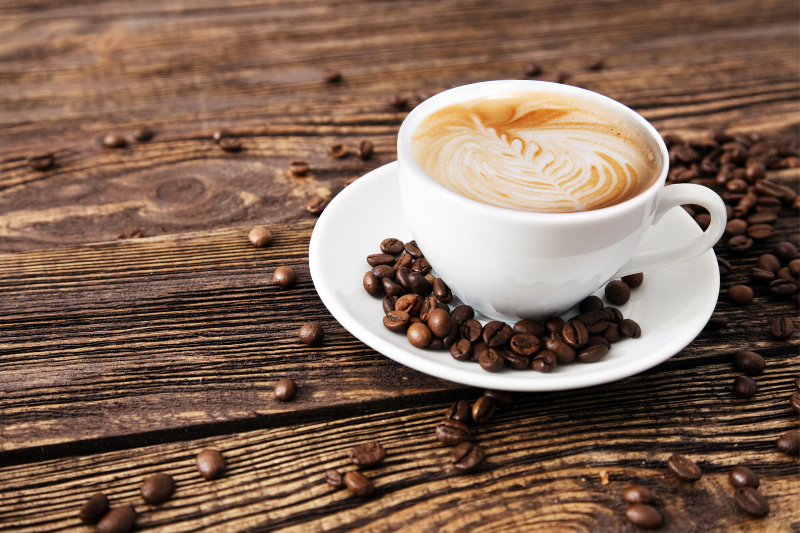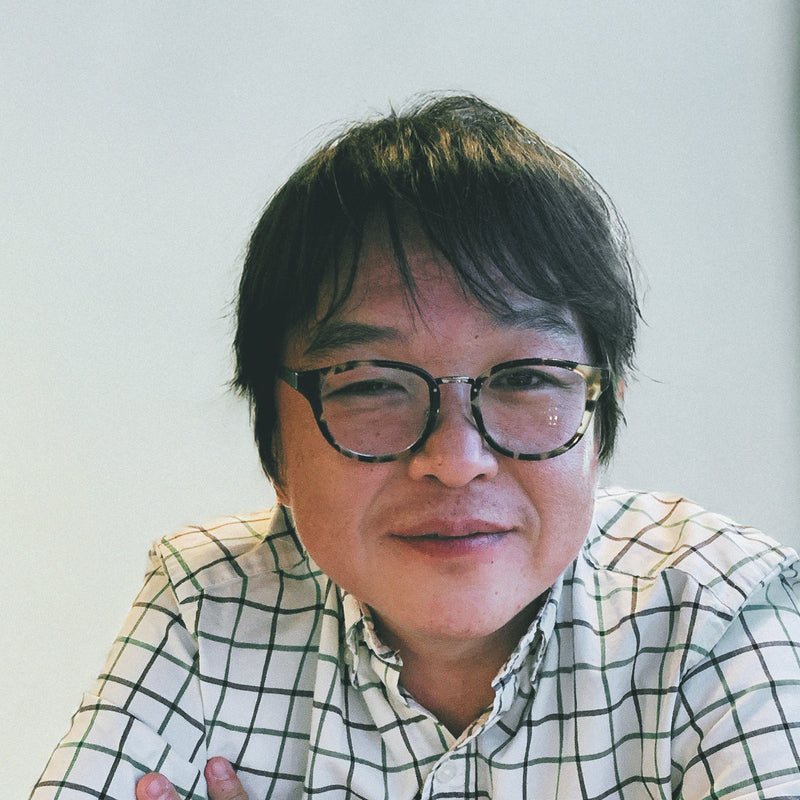What is Special About Charcoal Sumiyaki Coffee Roasting?
First of All - What is Roasting?
You might be wondering what 'roasting' means in a literal sense, but, put simply, it is just like 'baking' coffee beans. This might come as a surprise to many, but coffee beans grow inside beautiful red cherries. Once these cherries have been harvested from the coffee plants, the unwanted parts of the cherries, such as the skin and pulp, are removed and, as a result, we get fresh green coffee beans!
The green coffee beans in their raw form are far from ready to be made into a delicious cup of coffee. This is where the crucial process of ‘roasting’ comes into the picture. Due to the process of ‘roasting,’ the coffee beans become ready to be brewed with the addition of hot water. The result of this is the delicious, aromatic, and almost magical drink that many of us know by the name ‘drip coffee’ or ‘pour-over coffee.’
 Picture of a coffee roaster
Picture of a coffee roaster
Type of Roasting: Hot Air Roasting vs. Direct Fire Roasting
Now that we have a basic idea of what the roasting of coffee beans means let’s dive a little deeper into the fascinating world of coffee roasting. The coffee roasting process can be roughly divided into two major types. What is interesting is that the taste of the coffee is dependent on the type of method used for roasting.
The first type is called “Hot Air Roasting,” and as the name suggests, it is a method that uses high-temperature air to roast coffee beans. To have a mental image of what it is like, we can think of it as roasting the beans using a dryer that gives out fairly hot air. Coffee beans that are roasted using this method tend to result in light-roasted coffee.
The second type, called the “Direct Fire Roasting,” is a method where the coffee is roasted using fire from a gas burner. This can be compared to grilling meat on a barbecue. This type of roasting tends to result in darker roasts and gives the resulting coffee a more pungent taste.
 Picture of a coffee roaster
Picture of a coffee roaster
A third new type of roasting – Charcoal roasted coffee
The “hot air roasting” and “direct fire roasting” have been the two predominant types of roasting in the world of coffee, but an exciting third type of coffee roasting has emerged and is quickly gaining popularity. Let us introduce you to - Charcoal roasted coffee. As evident from the name, this method uses charcoal as a heat source to roast coffee beans.
Since it wasn’t until recently that the rest of the world started learning about it, people assume that charcoal-roasted coffee is a fairly fresh innovation in the coffee world. As a matter of fact, it has been in use in Japan and other parts of Asia for a long time.
For the most part, charcoal-roasted coffee was an artisanal proposition. It was produced in local coffee shops that did their own roasting. It wasn’t until the 1980s when Japanese coffee company UCC started large-scale production of charcoal-roasted coffee and began selling it nationwide.
UCC’s charcoal-roasted coffee products soon made their way overseas, and the world finally started to get to know the unique offering that was Japanese Sumiyaki Coffee.
Click here to read more about UCC's Charcoal-Roasted Coffee
 Picture of binchotan charcoal
Picture of binchotan charcoal
One of the most significant advantages of using the charcoal roasting method as opposed to the other methods is the effect of Infrared and Far Infrared Rays. Some of us might already be familiar with new types of rice cookers since they are so trendy nowadays. They use a similar concept to charcoal grilling. Due to the effect of Infrared and Far Infrared Rays, the coffee beans are cooked deeply from the inside, and the resulting roasted beans have a plump and fluffy finish.
Besides, charcoal roasting has the effect of slowing down the deterioration rate of coffee beans. The deterioration of coffee beans can be described in simple terms as the loss of flavor, taste, and aroma of the coffee, which we are all familiar with and want to avoid or at least slow down at all costs. This happens because the moment the coffee beans come out of the roaster, the beans start to undergo oxidation due to the surrounding air. The good thing about charcoal roasting is that when charcoal is burnt, it gives off a large amount of Carbon monoxide. This Carbon monoxide delays the oxidation process and, as a result, prolongs the shelf life of roasted coffee beans.

Picture of Charcoal Coffee Roasting
Not only does charcoal roasting protect the coffee against oxidation, but it also gives the coffee a unique flavor that would be unattainable through any other method. Anyone who has used charcoal for cooking would be familiar with the sheer richness of aroma and flavor that can come from charcoal grilling. Coffee beans that have been roasted using charcoal carry the aroma of charcoal, which can be described as the perfect balance of sweet, smoky, and savory. Hence, charcoal-grilled coffee tends to have a strong taste and would be highly regarded by anyone who loves smoky, rich, strong, and savory coffee.
What is so special about charcoal roasting?
The traditional roasting methods have been well established as a tried-and-true method over time. Compared to those, the charcoal roasting method is quite time-consuming and can be expensive as well. So then, why do we still prefer the charcoal roasting method?
1. Because it removes the excessive water hidden inside raw coffee beans:
One of the most essential aspects of roasting coffee beans is the removal of excess water from the beans. If the water is not completely removed through roasting, the remaining moisture within the coffee gives it an unpleasant smell and acidity. To effectively remove moisture from within the coffee beans, it is crucial to transfer heat to the core of the beans. One of the things that charcoal grilling does very well is to transmit heat directly to the core of the beans, which in turn removes any unwanted taste or flavor profiles from the resulting roasted coffee.
2. Because the fire reaches deep into the core of the beans and gives the beans a fluffy finish
Far Infrared rays are given off when charcoal such as Binchotan charcoal is burnt (Binchotan is a type of activated charcoal traditionally used in Japanese cooking and is also known as white charcoal). Far infrared rays have the property of being easily absorbed by substances other than metals. This tendency of Far Infrared rays to be easily absorbed by the coffee beans makes the heat reach the center of the beans, resulting in plump coffee beans that are baked uniformly throughout their body. As we can imagine, when each bean has been uniformly baked with a fluffy finish, a cup of coffee brewed from this roast would have a balanced, well-rounded taste and flavor profile, as well as a smooth mouth feel.
3. Because the roasting style is so distinctly Japanese
The Sumiyaki roasting technique is part of Japanese coffee culture, which is why Sumiyaki Coffee is readily available in the country. However, this is not the case abroad. Typically, getting Sumiyaki Coffee from elsewhere means ordering it online. Enjoying it outside Japan allows the drinker a taste of Japan’s unique coffee experience for those who haven’t been yet or a reminder of the sensation for those who have already been.
 Adding Charcoal to Charcoal Coffee Roaster
Adding Charcoal to Charcoal Coffee Roaster
Charcoal roasting ( Sumiyaki roasting) VS. Gas burner roasting
The most significant difference between gas-burner roasting and charcoal roasting of coffee is the absence of Far Infrared rays* in the former and the presence of Far Infrared rays in the latter.
Far Infrared Rays: Far Infrared rays are electromagnetic rays that lie between visible light waves and microwave (the waves used in microwave ovens). These Far Infrared Rays have the effect of heating substances from within by making the water molecules inside the cells.
As we have read earlier, the most commonly used coffee roasting machines use gas burners as heat sources. Inside these machines, coffee beans are heated only on their outer surfaces, which makes them vulnerable to differences in the level of roasting between the inside and the outside surfaces. Therefore it is common for roasters to set the roasting temperatures higher when using gas roasters in an attempt to make the heat reach the insides of the coffee beans. A common problem, which is not so difficult to guess, is that in this method, the outer surface of the coffee beans can quickly get over-burnt. This unwanted result can easily happen using gas roasters anytime a roaster tries to produce a roast profile that is darker than a medium roast.
When brewed, a coffee roast like this will give off an unpleasant sourness. Also, this batch of coffee will have all of its wonderful chemical ingredients decomposed, losing their original quality, making it impossible to produce any depth or complexity of taste, flavor, and aroma. From a coffee connoisseur’s standpoint, this is an absolute tragedy! Many of us who regularly drink coffee must be familiar with the impression that darker and bitter coffee tends to have a simple, clean taste with minimum complexity. However, take this darkness one notch higher, and you will get a coffee that has a putrid, burnt smell and leaves an extremely bitter aftertaste that torments your palate for a good while.
 Temperature differences between gas and charcoal roasting
Temperature differences between gas and charcoal roasting
Now let’s take a look at the scenario in the case of charcoal roasting and appreciate how different it is from the traditional method. In the case of the charcoal roasting method, the outer surface of the coffee beans can be roasted by “the heat generated from charcoal,” and the inner surface of the coffee beans can be cooked by the “heat generated by Far Infrared rays.” These two processes of heating the outer surface and the inner surface of the coffee beans happen simultaneously, and Voilà!
This results in a coffee roasting process that can occur at a lower temperature than the gas burner process and within a shorter period of time. This also means that it is easier to control the heat reaching the outer surface and the inner surface of the coffee beans.Therefore, the overcooking or “burning” of the coffee beans can be avoided easily.
This, in turn, helps to preserve the special chemical ingredients within the coffee beans so that they don’t lose their originality. Since the coffee beans are able to retain the elements that give them their unique flavors and taste, when charcoal-roasted coffee is brewed, it results in a full-bodied, well-rounded cup of coffee with richness and depth in flavor, taste, and aroma.
Moreover, as the heat can easily reach the core of coffee beans, the acidity or “sourness” of the coffee tends to decrease. There is a clear difference between the levels of sourness between a medium roast made using the gas-burning method and the charcoal roasting method. Also, unlike gas roasting, which can only be controlled using a valve, charcoal roasting has a more considerable scope of adjustment. However, this adjustment is not easy and requires a high level of expertise. Depending on a roaster’s knowledge and skills, the path taken by the fire in charcoal roasting can change slightly on each roast.
About Binchōtan (Binchō Charcoal)
Binchō-tan is a type of activated charcoal (also known as white charcoal) that uses oak as a raw material. Interestingly, the word “Binchō” came from the name of a person called Bichū-ya Chōzaemon. He was the pioneering craftsman from Tanabe city, Kinokuniya, who first started to sell this charcoal he made from Ubame oak, which has since been called after his name.
 Picture of Kisyu Binchotan
Picture of Kisyu Binchotan
The three primary producers of Bincho charcoal are:
- Wakayama prefecture (producing Kishu Binchō-tan).
- Kochi prefecture (producing Tosa Binchō-tan).
- Miyazaki prefecture (producing Hinata Binchō-tan).
Among them, the Binchō-tan that uses Ubame oak as the raw material is known to be the best.
Click here to read more about Binchotan
Binchō-tan charcoal is recommended for roasting
Binchō-tan charcoal is a special kind of charcoal in the sense that it does not have moisture content. Moreover, it has a chemical structure that makes it hard to ignite. As a result, once it is ignited, it can generate a large quantity of heat. It can reach an astoundingly high temperature - as high as 1000 ° C. Charcoal roasting is one of the methods that require a high level of expertise and experience to master, as it is challenging to maintain constant thermal power. However, when it comes to Binchotan charcoal, a relatively stable roasting can be performed as Binchotan charcoal has a high calorific value, long burning time, and gives out a high level of Infrared rays.
While Bincho charcoal is the standard for Japanese sumiyaki coffee, other charcoal-roasted coffee products routinely make use of different types of charcoal. For instance, in Hirosaki, a place that has been dubbed “Coffee Town,” locals roast their coffee using Meiya charcoal, which comes from apple wood. Incidentally, the area is known for both being Japan’s biggest apple producer and having a charcoal-producing industry.
Outside of Japan, there are also coffee producers that make use of charcoal in roasting their coffee. An example would be a more than 60-year-old coffee factory in Klang, Malaysia. It uses black charcoal to produce traditional Hainanese Coffee.
Nonetheless, for a proper Sumiyaki Coffee experience, roasting with Bincho-tan charcoal is called for.
Disadvantages of charcoal roasting – are there any?
Sadly, yes. By this point, we have learned a lot about the wonders charcoal roasting can do for coffee and how preferable it is as an emerging roasting technique. That being said, negative opinions about charcoal roasting are not non-existent. The most typical complaint regarding charcoal roasting is that the adjustment of thermal power, which is an indispensable factor when it comes to roasting, is difficult to perform using the charcoal roasting method. Coffee roasting is neither a simple scientific reaction nor a purely technical method. It would be more appropriately described as a delicate combination of art and science that requires the roaster to have a subtle artisan-level sensory flair. Since it is so difficult to control the roasting conditions using charcoal roasting, compared to the hot-air method and gas burner method, many argue that charcoal roasting is not suitable for coffee roasting to begin with.
And above all, the problem with charcoal roasting, which cannot be ignored, is its high cost. Compared to the traditional roasting methods, the charcoal roasting method has a much higher fuel cost. In addition, the preparation and cleaning up are more complicated in the case of charcoal roasting.
Having said that, it seems that both Sumiyaki Coffee’s advantages and disadvantages work in conjunction to make it the unique premium offering that it is. That’s why it has taken off in popularity worldwide.
 Image of Charcoal Roasting Coffee
Image of Charcoal Roasting Coffee
This post was first published in 2021 but it was updated in 2023 just for you.
Get Free Bonus Books

Sign up for free to the Coffee Club to get advice and exclusive articles about how to choose Japanese Coffee, and tips, tricks, and recipes for enjoying Japanese coffee.
About the author
Kei Nishida
Author, CEO Dream of Japan
Certification: PMP, BS in Computer Science
Education: Western Washington University
Kei Nishida is a passionate Japanese tea and coffee connoisseur, writer, and the founder and CEO of Japanese Coffee Co. and Japanese Green Tea Co., both part of Dream of Japan.
His journey began with a mission to introduce the world to the unparalleled quality of Japanese green tea. Through Japanese Green Tea Co., he established the only company that sources premium tea grown in nutrient-rich sugarcane soil—an innovation that led to multiple Global Tea Champion awards.
Building on this success and his passion for Japanese craftsmanship, Kei expanded into the world of coffee, pioneering the launch of Japanese Coffee Co., the first company to bring Sumiyaki charcoal-roasted coffee to a global audience. His dedication to authenticity and quality ensures that this traditional Japanese roasting method, once a well-kept secret, is now enjoyed worldwide.
Beyond tea and coffee, Kei has also introduced Japan’s legendary craftsmanship to the world through Japanese Knife Co., making handmade katana-style knives—crafted by a renowned katana maker—available outside Japan for the first time.
Kei’s journey continues as he seeks out and shares the hidden treasures of Japan, one cup and one blade at a time.
Learn more about Kei


